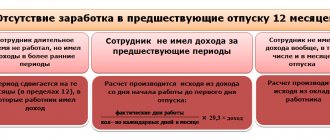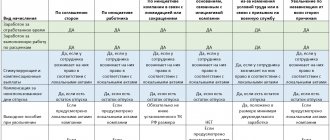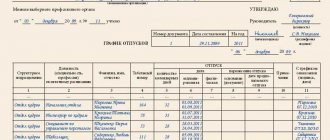According to Article 127 of the Labor Code of the Russian Federation, upon dismissal, an employee is paid monetary compensation for unused vacation. In the 1C: Salary and Personnel Management 8 program, the number of days of unused vacation for which compensation should be paid upon dismissal is determined automatically. E.A. talks about the procedure for calculating the rest of the vacation in the program. Gryanina, independent consultant.
The employer’s obligation to pay compensation to the employee upon dismissal for all unused vacations is enshrined in the Labor Code, but neither the Labor Code nor other regulations contain precise instructions on how to calculate the number of days. Obviously, the number of days of unused vacation is determined as the difference between the number of vacation days “earned” by the employee and the number of days of vacation actually granted to him. The number of days of vacation actually granted is not difficult to determine, but the algorithm for calculating the number of vacation days “earned” by an employee is not so simple and unambiguous.
First, this requires determining the employee’s length of service. This point does not raise questions, since the procedure for determining length of service is prescribed in the Labor Code.
According to Article 121 of the Labor Code of the Russian Federation, the length of service that gives the right to annual paid leave includes:
- actual work time;
- the time when the employee did not actually work, but in accordance with labor legislation and other regulatory legal acts containing labor law norms, a collective agreement, agreements, local regulations, an employment contract, he retained his place of work (position), incl. time of annual paid leave, non-working holidays, weekends and other rest days provided to the employee;
- time of forced absence due to illegal dismissal or suspension from work and subsequent reinstatement to the previous job;
- the period of suspension from work of an employee who has not undergone a mandatory medical examination (examination) through no fault of his own;
- the time of unpaid leave provided at the request of the employee, not exceeding 14 calendar days during the working year.
The length of service that gives the right to annual basic paid leave does not include:
- the time the employee is absent from work without good reason;
- time of parental leave until the child reaches the legal age.
Next, it is necessary, based on the length of service received, to calculate the number of vacation days due to the employee. In general, the duration of annual leave is 28 calendar days (Article 115 of the Labor Code of the Russian Federation). That is, for each full year of service, or working year, the employee should “accrue” 28 calendar days of vacation. The Labor Code does not contain explanations on how to calculate the number of vacation days for an incompletely worked working year. The only regulatory document regulating this issue is the Rules on regular and additional leaves, approved. NKT of the USSR 04/30/1930 No. 169 (hereinafter referred to as the Rules), which are still applied to the extent that does not contradict the Labor Code of the Russian Federation.
According to paragraph 28 of the Rules, employees who have worked in the organization for at least 11 months, included in the length of service giving the right to leave, receive full compensation; in other cases, employees receive proportional compensation. Based on the calculation examples presented in the Rules, we can conclude that in order to calculate proportional compensation, the number of vacation days due to an employee should be determined by dividing the established duration of vacation (generally 28 calendar days) by 12 months and multiplying by the number of months of the employee’s vacation period . Moreover, in order to calculate proportional compensation, the employee’s vacation period, which, as a rule, at the time of dismissal of the employee is an incomplete number of months, should be rounded to whole months. The rules for rounding service are set out in paragraph 35 of the Rules: surpluses amounting to less than half a month will be excluded from the calculation, and surpluses amounting to at least half a month are rounded up to a full month.
In practice, this procedure for calculating unused vacation days can be interpreted differently.
Firstly, the question raises the question of rounding the employee’s length of service to a whole number of months: what is considered “surplus amounting to less than half a month” and “surplus amounting to at least half a month”. The number of days in different months is different: will 14 calendar days of service in February be considered half a month, like 15 days of service in March?
The second common question is whether the number of days of vacation compensation should be rounded, and can the number of days be a non-integer? For example, an employee worked for 1 month, and as a general rule he is entitled to 28/12 days of vacation. The result is 2.33 (3) days. Should compensation be paid in 2.33 days or should 2.33 be rounded to the nearest whole number of days? Please note that rounding of the number of calendar days of unused vacation to be paid when calculating compensation for unused vacation is not provided for by law. However, if an organization makes a decision to round, for example, to whole days, then, according to the letter of the Ministry of Health and Social Development of Russia dated December 7, 2005 No. 4334-17, this should be done not according to the rules of arithmetic, but in favor of the employee, i.e. 2, 33 should be rounded to 3 days.
We also note that some experts are of the opinion that compensation should be calculated based on the monthly number of vacation days rounded to two decimal places, i.e. take into account 2.33 days for each month of vacation experience. That is, if an employee worked for 2 months, then he is entitled to compensation for 2.33 x 2 = 4.66 days of vacation. The result obtained, however, will differ from that calculated and rounded according to the rules of mathematics: 28 / 12 x 2 = 4.67 days. Which calculation option should be used?
These methodological issues are resolved in the 1C: Salary and Personnel Management 8 program as follows: the algorithm for calculating days of compensation for unused vacation is implemented in maximum compliance with regulatory documents, and controversial and ambiguous issues are resolved in favor of employees:
1) When calculating vacation experience, the number of full months is calculated from the date of admission according to the calendar principle, i.e. for example, if an employee was hired on January 17, then on February 16 his experience will be exactly one month, on March 16 exactly two months, etc. Accordingly, on the date of dismissal, the employee’s length of service entitling him to annual leave will be a number of full months and a number of days. This number of days is considered “surplus”.
For example, if an employee hired on January 17, 2013, quits on March 3, 2013, then his vacation period will be exactly 1 month (from January 17 to February 16) and an excess of 15 days (12 days - from February 17 to 28 and 3 days from March 1 to March 3).
To determine whether the surplus is less than half of the month or at least half, you need to select a month and divide the number of days in that month in half. In the 1C program, the calendar month that contains the largest number of days in the employee’s last working month is selected for analysis. In the example under consideration, this is March. The employee's last working month is the period from February 17 to March 16 (if he had completed it completely, he would have earned a full month of experience). In this period, 12 days fall in February and 16 days in March, hence March is selected for analysis. There are 31 calendar days in March, which means that the excess of 15 days is less than half the month (31:2 = 15.5). Thus, this excess is discarded and the employee’s length of service is considered to be 1 month.
Note that if the employee quit on March 4, then his length of service would be 1 month and 16 days, 16 days is an excess amounting to more than half a month, therefore, to calculate days of vacation compensation, the employee’s length of service would be rounded to 2 whole months.
If the employee’s dismissal date fell after March 17, then April would have been selected for calculating half of the month, because The last working month would be considered the period from March 17 to April 16. Let, for example, the employee’s dismissal date be March 31, 2013, then the employee’s length of service is 2 full months (from January 17 to March 16) and 15 days (from March 17 to March 31). In this example, the excess of 15 days is already exactly half of the month of April (30 calendar days: 2), therefore, it is rounded up to a full month, and the calculation of vacation compensation days is based on 3 months of vacation experience.
2) For 11 full months worked, full compensation is calculated, i.e. as if the employee had worked a full working year (however, if the employee worked for less than 11 months, for example, 10 months and 20 days, then the number of days of compensation is calculated proportionally - for 11 months of vacation experience).
3) When calculating proportionally, the number of days of vacation compensation is calculated without intermediate rounding, and the final result obtained using the formula is rounded:
<Number of earned vacation days> = <Annual number of vacation days>/ 12 x <Number of months of vacation experience>.
Thus, if an employee quits after working for 2 months, then the program will offer him compensation for 28 / 12 x 2 = 4.67 days of vacation, and not 4.66 days. This approach, firstly, does not infringe on the rights of employees (compensation for 4.67 days will be greater than for 4.66), and secondly, it allows you to accurately calculate compensation for 3, 6 or 9 months of work. The number of compensated vacation days in this case will be 7, 14 and 21 vacation days, respectively. When applying the calculation, based on 2.33 days of vacation per month of service, the number of days of compensation will be 6.99 days for 3 months of work, 13.98 for six months, 20.97 days for 9 months, which is clearly not expected the result of the calculation, first of all, for the employee himself.
In addition, the program implements the ability to calculate days of vacation compensation, rounded to whole days. This feature is enabled in the accounting settings. Due to the low prevalence of this technique, by default the option Round off vacation compensation days upon dismissal is disabled in the program.
When the option is enabled, the number of days of vacation compensation is rounded to whole days, and always upward, which corresponds to the rounding rules set out in the letter of the Ministry of Health and Social Development of Russia dated December 7, 2005 No. 4334-17.
Determination of length of service
Before accruing compensation payments to the employee, the number of days allotted for vacation is determined . To do this, calculate the total time worked. The starting point is the day the employee joins the enterprise. An employee has the right to apply for annual paid leave of 28 calendar days.
This right is granted to each employee after 11 months worked at the enterprise. You are allowed to take a vacation after 6 months, but the rest period will be shorter.
It should be noted that the Labor Code does not determine the procedure for establishing the number of rest days accumulated by an employee at the time of dismissal.
For these purposes, one should resort to the clauses of the Rules on regular and additional leaves in an article consistent with Labor legislation. Thus, a resigning employee who has worked at a certain enterprise for at least 11 months and has not exercised his right to leave is entitled to full compensation.
Cheat sheet on compensation for unused vacation
We bring to your attention a reminder that will help you quickly calculate compensation for unused vacation. Moreover, both when an employee is fired, and in the case when the employee remains working in the company, but wants to get money instead of rest. We have focused on when these payments are calculated the same and when there are differences.
DIFFERENCES: In what cases is it necessary to pay compensation Compensation associated with dismissal
The accountant will have to calculate and accrue this payment if the employee is dismissed on one of the grounds provided for by the Labor Code of the Russian Federation. For what reason, it doesn’t matter. Compensation is due in any case. Including upon dismissal through transfer to another company.
But here are the situations when it is not necessary to issue compensation: - an external part-time worker was transferred to the main place of work in the company (this is precisely the case of transfer; if the part-time worker first wrote a letter of resignation, and then an application for employment, then it is necessary to pay compensation) ; - the employee worked for the company for less than half a month (the accountant needs to calculate how many calendar days fall on the time worked; and if this is less than half of the total number of calendar days in a given month, then compensation does not need to be paid).











